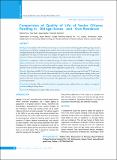Please use this identifier to cite or link to this item:
https://hdl.handle.net/20.500.14356/1189| Title: | Comparision of Quality of Life of Senior Citizens Residing in Old Age Homes and Own Residence |
| Authors: | Piya, Nebina Shah, Tara Badhu, Angur Shrestha, Sharmila |
| Citation: | UpretiR., OliU., BhattaraiS., BaralD., & Sharma PoudelI. (2020). Family Planning Practice among People Living with Human Immuno Deficiency Virus/Acquired Immune Deficiency Syndrome. Journal of Nepal Health Research Council, 18(1), 10-15. https://doi.org/10.33314/jnhrc.v18i1.1775 |
| Issue Date: | 2020 |
| Publisher: | Nepal Health Research Council |
| Article Type: | Original Article |
| Keywords: | Old age homes quality of life senior citizens |
| Series/Report no.: | Jan-Mar 2020;2050 |
| Abstract: | Abstract Background: Quality of life of elderly is becoming even more relevant with demographic shift happening towards an ageing society. With fast changing family condition and social contexts, lives of elderly people in Nepal have been changing dramatically. Old age homes have sprung up to cater to the needs of the elderly from different socio-economic backgrounds. The objective of this study is to compare the quality of life of senior citizens of selected old age homes and own residence and to find the association of quality of life with selected study variables. Methods: A comparative study was conducted among 120 senior citizens from Dhankuta, Morang and Sunsari districts of Koshi zone. Two strata were formed based on their residence, i.e., old age homes and own residence. Equal proportion of the samples were selected from both the settings. Data was collected using interview schedule through pretested semi-structured and standard World Helth Organization, quality of life – old questionnaires. Results: More than one fifth (23.33%) of research participants were from the age group 65-69 and 75-79 and more than half (55%) of them were female. More than half (58.33%) of the research participants residing in their own residence had high quality of life level, while among those residing in the old age homes, only about 40% had high quality of life level. Quality of life level was found to be significantly associated with sex and educational status of the research participants. Conclusions: Quality of life was found to be better among the people residing in their own residence as compared to those residing in old age homes. Keywords: Old age homes; quality of life; senior citizens |
| Description: | Original Article |
| URI: | http://103.69.126.140:8080/handle/20.500.14356/1189 |
| ISSN: | JNHRC Print ISSN: 1727-5482; Online ISSN: 1999-6217 |
| Appears in Collections: | Vol. 18 No. 1 (2020): Vol. 18 No. 1 Issue 46 Jan-Mar 2020 |
Files in This Item:
| File | Description | Size | Format | |
|---|---|---|---|---|
| 2050-Manuscript-14299-1-10-20200420.pdf | Fulltext Article. | 193.98 kB | Adobe PDF |  View/Open |
Items in DSpace are protected by copyright, with all rights reserved, unless otherwise indicated.
